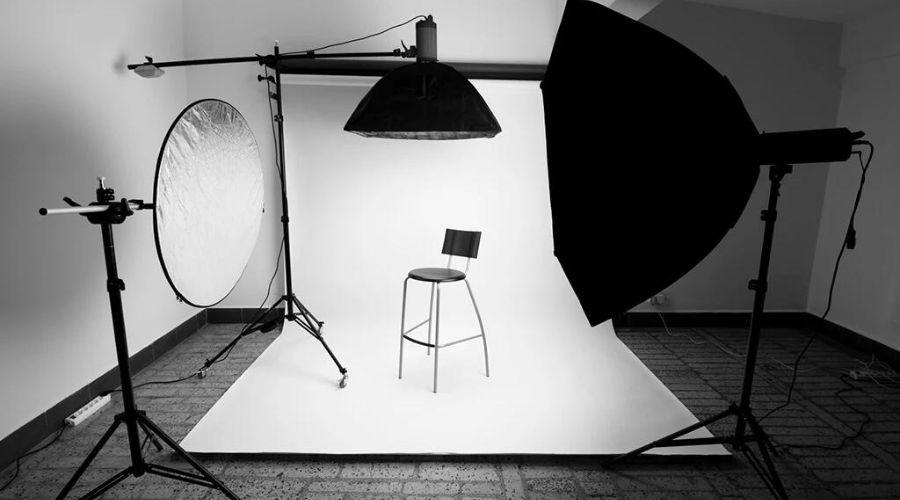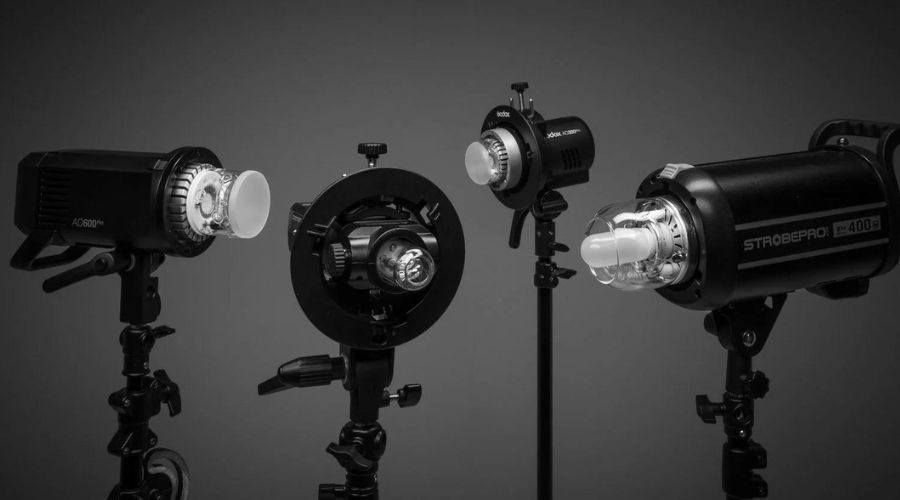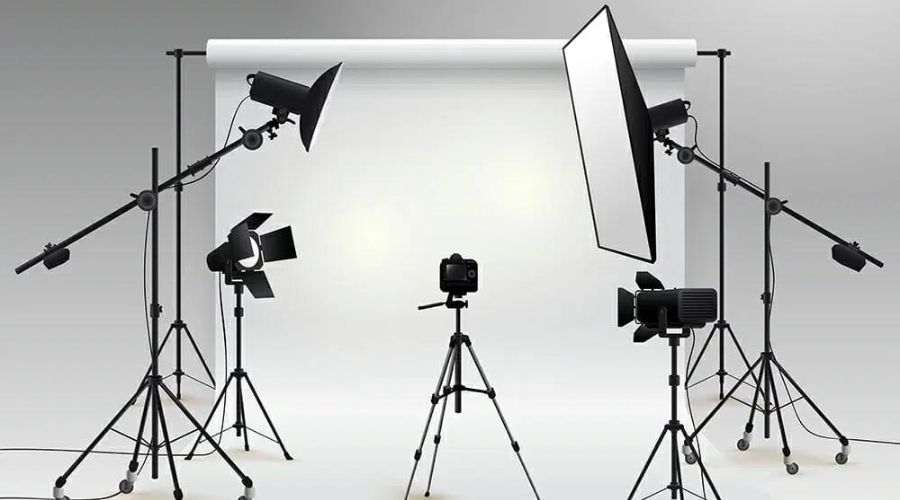Natural vs. Artificial Lighting Equipment
When diving into the world of photography lighting equipment, you’ll bump into two buddies—natural and artificial lighting.
Let’s untangle their wires and see which one brightens up your snaps the best.
Pros and Cons of Natural Lighting
Ah, natural lighting! It’s like that friend who shows up unannounced but always makes your day better.
You get this freebie courtesy of Mr. Sun, and it can make your photos look as fresh as a daisy. There’s a warmth and authenticity with natural light that’s hard to beat.
But let’s face it, relying on the sun can sometimes be as fickle as a cat in a yarn shop. Clouds roll in, and bam!
Your perfect shot is dimmer than a firefly in daylight. If you’re chasing consistency, natural light might play hard to get.
When to Use Artificial Photography Lighting Equipment
Okay, so when do you turn to artificial lights?
Imagine you’re trying to shoot a moody portrait, and you want shadows as soft as a teddy bear’s hug.
Natural light is playing peekaboo behind the clouds. That’s your cue to bring out the big guns—strobes, LEDs, ring lights, you name it! These tools don’t care about the weather; they’ll give you the glow-up you need, rain or shine.
Plus, you can tweak them to be bright as Broadway or subtle as a secret.
Just remember, with great power comes great responsibility—knowing how to work these gizmos is key to avoid photos that look like a deer in headlights.
With a good understanding of when to use natural versus artificial lighting equipment, you’ll take your photography game from so-so to showstopper. And always keep in mind, whether your lighting is coming from the cosmos or a cord, it’s all about how you harness that glow to create your masterpiece.
Continuous Lighting Equipment
When you dive into the types of photography lighting equipment, you’ll surely bump into continuous lighting.
Let’s flip the switch and shed some light on what this all means for you.

Defining Continuous Lighting
Imagine the sun hanging around in your studio, never dipping below the horizon—that’s continuous lighting for you.
It’s a steady, constant glow that makes sure shadows don’t play hide and seek while you’re trying to snap the perfect shot.
Types of Continuous Lights
You’ve got options, folks! From the good ol’ tungsten that’ll give your pics a warm hug, to fluorescent lights that are cooler than a polar bear’s toenails.
And then there’s LED—these little guys are the energy-saving superheroes of the lighting world.
Common Uses for Continuous Lighting in Photography
If still life could talk, it would tell you it loves continuous lighting. Why? Because it’s perfect for capturing that antique vase or mouth-watering pastry without the rush.
Video creators are also best buds with continuous lights, as they help avoid that flicker effect that can make videos look like a disco gone wrong.
And there you have it, a quick tour through the land of continuous lighting.
Remember, finding the right light is like finding the right pair of jeans—it can make or break your look. So go ahead, play around, and find the glow that makes your photos pop!
When diving into the types of photography lighting equipment, strobe lighting often steals the spotlight. These babies pack a punch, offering a burst of light that can turn night into day faster than you can say “cheese”.
So, let’s say you’re keen to freeze a moment like a superhero freezes a villain; strobe lighting is your go-to sidekick.
Strobe Lighting Equipment

Understanding How Strobe Lighting Works
Think of strobe lights as the flash on your camera, but like, on steroids. They wait patiently in the dark until you hit the shutter button. Boom! They burst into action with a powerful flash.
Why’s that cool? Because they help you capture crisp images where every glittering detail is frozen in time. Trust me, for action shots, they’re the real MVP.
Different Types of Strobe Lights
So, you’ve got monolights, which are lone wolves of the strobe world. They’re independent and have their own power source.
Then there are power pack systems; they’ve got all the muscle, powering several heads at once. This is like having a whole team working for you instead of a solo artist.
Strobe vs. Continuous Lighting: Making the Right Choice
Choosing between strobe and continuous lighting can feel like picking your favorite ice cream flavor—tough, right? Strobe is a one-hit-wonder, awesome for that snapshot effect.
Continuous lighting, on the flip side, is the constant glow, the sun to your moon, giving you the power to see the effect in real-time.
So, what’s your jam? Quick surprise flashes or the steady glow of sunshine? Your choice sets the stage for the magic you create.
You’ll notice that flipping through your lighting options isn’t rocket science. Even without previous know-how, you can start mixing and matching these tools to light up your shots like a Fourth of July barbecue.
As you put these puzzle pieces together, your photos will start popping off the page (or screen), and you’ll feel like a lighting wizard in no time.
Just remember, every piece of gear is a tool in your belt, ready to elevate your photographic shenanigans to levels of awesomeness previously unknown.
On-Camera Flashes and Speedlights
So, let’s jump right in and shed some light on types of photography lighting equipment, starting with on-camera flashes and speedlights.
You’ve probably noticed that little pop-up thingy on top of cameras, right? That’s the on-camera flash, your go-to gear when you need a quick burst of light to snap a pic in dim situations.

Overview of On-Camera Flash
On-camera flashes are like magic wands for photographers.
Just when you’re about to take a photo and the lighting is all shades of wrong, bam! You fire up the flash, and suddenly, your subject is lit up like a Christmas tree.
It’s a built-in light source that’s easy to carry because it’s, well, on your camera. You don’t need a degree in rocket science to use it, either. Just point, shoot, and watch the magic happen.
Advanced Features of Speedlights
Speedlights are like on-camera flashes’ cooler, tech-savvy cousin. They come with all these fancy buttons and settings that let you do more than just flash.
You can bounce light off walls for softer lighting, zoom the flash for concentrated light, or even sync it with your camera for high-speed action shots. It’s not just about brightness; it’s about getting smart with your lighting game.
Techniques for Using On-Camera Flashes Effectively
Using on-camera flashes is not just about lighting up a scene; it’s about doing it with style.
Try bouncing the flash off a ceiling or wall for that soft, angelic glow. Or how about diffusing it with a little piece of white cloth? It’s like putting a mini softbox on your flash.
These tricks can make the difference between a snapshot and a “that belongs in a gallery” shot. And, always remember to adjust the intensity of your flash. Blinding your subjects is no fun unless you’re into that deer-in-the-headlights look.
Listen, diving into the world of photography lighting doesn’t have to feel like trying to solve a Rubik’s cube blindfolded.
Keep it simple, light up your subjects with the gear you’ve got, and watch your photos go from meh to whoa.
Oh, and remember, practice makes perfect. So go ahead, give these tips a whirl and light up the world one click at a time!
Modifiers and Softboxes
When you’re elbow-deep in the types of photography lighting equipment, light modifiers and softboxes should be your ace in the hole.
Think of these handy tools as the Swiss Army knives of the lighting world. They shape, bend, and twist light to your will, making sure every shadow and highlight shows up to the party dressed to impress.
Purpose of Light Modifiers in Photography
Alright, let’s talk light modifiers. These gizmos are your ticket to the big leagues. They’re like the maestros of the orchestra, conducting light in symphonies and solos around your subject.
Want a dramatic portrait with shadows that whisper secrets? Or maybe a product shot so crisp it makes your mouth water? That’s the magic of a good modifier—you get to paint your scene with light, adding depth, drama, or diffused serenity.
Different Types of Softboxes and Their Uses
Softboxes are the bread and butter of portrait photographers. They come in all shapes and sizes, each with its own part to play.
You’ve got your square, rectangle, and octagon—each dishing out their own flavor of light. Squares and rectangles are like the reliable friends, great for even light spread on products or headshots.
Octagons? They’re the life of the party. They toss out a natural, almost sun-like glow that makes eyes twinkle and skin sing. Use them for glamor shots where you need that soft, ethereal touch.
Tips for Choosing the Right Modifier for Your Subject
Now, hold your horses before you run out and buy every modifier under the sun.
Remember, it’s not about the size of your toolbox but how you use your tools. Peep at your subject, squint a little, and think—what story do I wanna tell? Snappy shadows for a moody vibe, or a soft hug of light for a cozy feel? Choose a modifier that fits that narrative.
You’re the artist, and the right modifier is your brush, so paint bold, paint bright, and let your lighting shine as unique as your vision.
Umbrellas and Reflective Equipment
The Role of Umbrellas in Photography Lighting
Think of umbrellas as the Swiss Army Knives in your lighting toolkit. They spread light faster than gossip in a small town, turning a harsh flash into a soft, flattering glow.
Just pop one open, aim your light, and bam! You’ve got yourself a budget-friendly, easy-peasy light diffuser.
How to Use Reflective Equipment to Enhance Lighting
Now, reflective equipment is like having a good wingman. It’s there to have your back and bounce light right where you need it.
Don’t have the dough for fancy lights? No problemo! Grab a reflector, position it across from your main light source, and let it work its magic. You’ll kick shadows to the curb and light up faces like it’s the Fourth of July.
LED Panels and Ring Lights
Let’s cut to the chase about types of photography lighting equipment. If you’re looking to light up your photos like a Fourth of July barbecue, LED panels and ring lights might be your new best friends.
These two are the hotshots of modern lighting, and they’re more popular than a cute puppy on social media.
Benefits of Using LED Panels
So, you’re curious about LED panels, huh?
Picture this: you’re chilling with a light that’s as cool as cucumber, barely breaking a sweat. LED panels are the kings of cool light, practically whispering while traditional lights would be hollering.
Plus, these things sip electricity like it’s fine wine, so your energy bills won’t skyrocket. They’re also versatile, like a Swiss Army knife for photographers, perfect for anything from sultry portraits to vibrant product shots.
Exploring the Popularity of Ring Lights
On the flip side, ring lights are like the magic mirrors of the photography world.
You ever wonder how those beauty gurus look so flawless? Spoiler alert: it’s the ring light. It throws a halo of light that makes eyes twinkle and skin glow like you’re in a fairy tale.
And if you’re into selfies, ring lights are your fairy godmother, no pumpkin carriage required.
Choosing Between LED Panels and Ring Lights
Now, deciding between LED panels and ring lights is like picking your favorite ice cream flavor – it hinges on your taste.
Want to spread light like butter on toast? Go for LED panels. But if you’re after that superstar sparkle in the eyes, snag yourself a ring light. Each to their own, as they say.
Just remember, no light’s a one-trick pony, so play around and see what jazzes up your pictures the best.
Remember that a little experiment goes a long way. Don’t let chunks of tech jargon mess with your mojo. Keep it simple, Sherlock. Mix and match these dazzling lights and watch your photography shine bright like a diamond!
Let There Be Light on Your Photographic Journey!
Now that you’ve dipped your toes into the shiny waters of photography lighting equipment, you’re ready to light up the world with your snaps.
No matter what’s brewing in your creative pot, there’s a tool to sprinkle the perfect amount of light on your subject.
Remember, from umbrellas to softboxes, each piece of gear is like an ingredient in your grandma’s secret recipe: essential and transformative.
Just like a cat chases shadows, you’re now equipped to play with light and dark in your pictures. With this handy knowledge, you’ll be turning heads and dropping jaws with your snapshots in no time.
So, grab your camera, pick your poison of light, and shoot the breeze with your newfound friends in photography lighting gear land.
Keep your images shining bright, and never forget that the right flicker of light can turn a good photo into a masterpiece.
Frequently Asked Questions
What kind of lights do I need to start with in photography?
Starting out? A basic setup should include a main light, like a strobe or a continuous bulb. Also, consider throwing in a reflector to bounce light. This’ll add some pop to your shots without breaking the bank.
Are LED lights good for photography lighting?
Oh, absolutely! LED lights are like the Swiss Army knifes of photography—they’re versatile and won’t heat up your space. Plus, they save energy, so your wallet will thank you.
Do I have to spend a lot of money on lighting equipment?
No way! You don’t have to empty your pockets to get good lighting. Start with what you’ve got, maybe even a window and a simple reflector. It’s not about the gear, but how you use it!
What’s the difference between hard light and soft light?
Imagine a sunny day versus a cloudy one. Hard light is like sharp sunshine, casting strong shadows. Soft light? That’s your overcast day, smoothing out wrinkles with its gentle touch.
Should I use umbrella lights or softboxes?
Umbrellas and softboxes are both great options. Umbrellas are your no-fuss, easy-to-carry buddies. Softboxes are the detail-oriented friends, controlling light with precision. Choose based on your patience for setup and need for control.
Is natural light better than artificial light for photography?
Both have their moments! Natural light is free and fabulous, but it’s like a cat—comes and goes as it pleases. Artificial light is like a loyal dog, ready whenever you need it. Play with both and see what fetches you the best results.
Can I mix different types of light in photography?
Sure thing! Mixing light types is like a flavor fusion in a taco—sometimes it’s just what you need. Just watch the temperatures; you don’t want a cool LED clashing with a warm bulb. Keep it balanced and tasty.
What does ‘continuous lighting’ mean?
Continuous lighting is like the sun, always on during your shoot. It’s great for seeing what you get in real-time, rather than guessing like you might with flash. It’s always there, ready for action—just like your neighbor with the perfect lawn.
Do I need a flash for outdoor photography?
Well, that’s like asking if you need sunglasses on a beach day. Natural light can usually cut it, but a flash can fill in shadows and give life to the eyes. So, it’s not a must, but it sure can spruce up your sunny snaps!

